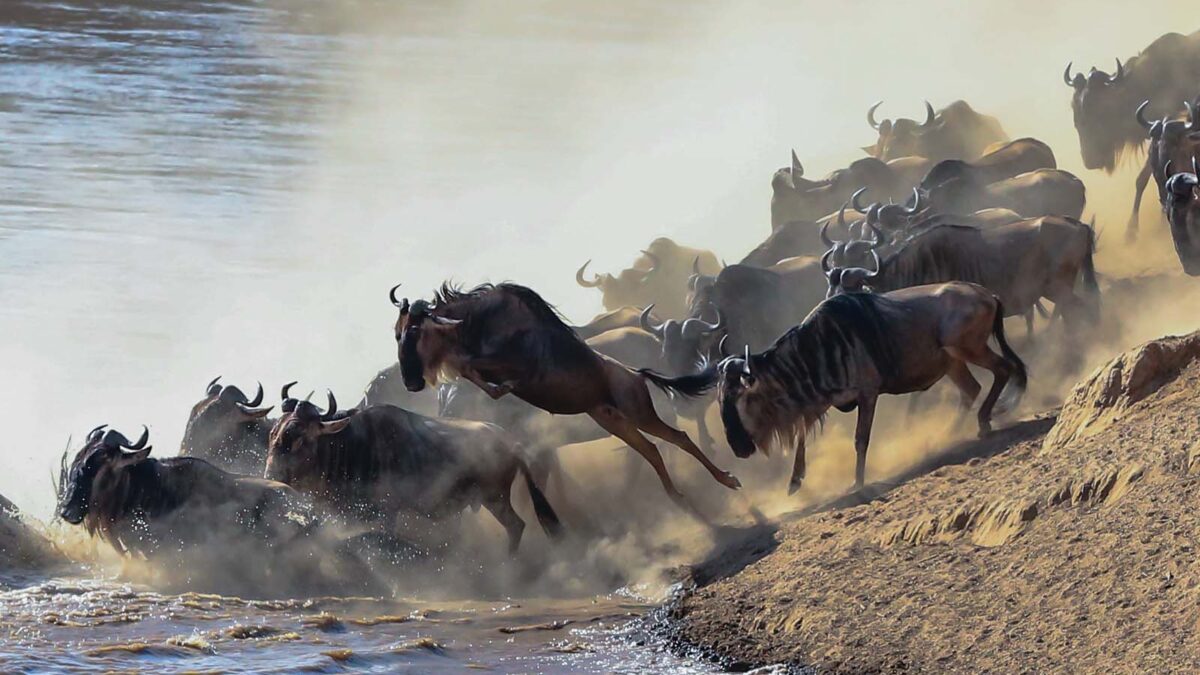Annual Wildebeest Herd Tracker Information

Vehicle etiquette on African Safaris
December 11, 2023
Mara River Wildebeest Crossing Safari
December 11, 2023Annual Wildebeest Herd Tracker Information – Insights into Tanzania and Kenya Safari
The annual wildebeest herd migration remains an enigmatic spectacle, prompting extensive research to fathom the motives behind millions of wildebeests and thousands of zebras undertaking the perilous journey from Masai Mara to Serengeti each year. Despite the formidable threats posed by predators on both land and water, the innate instinct driving this mass movement has piqued scientific curiosity.
Statistical Revelations on the Annual Wildebeest Migration
Scientific exploration, conducted with 30 GPS radio-collared wildebeests and zebras engaged in seasonal migration across the Serengeti-Mara ecosystem, delves into the interplay between top-down predation effects and bottom-up resource competition. The study scrutinizes individual movement patterns concerning grass biomass, high-quality food patches, and predation risk.
Contrary to expectations, wildebeests exhibit a propensity to move in response to food quality, displaying limited concern for predation risk. In contrast, zebras navigate a delicate balance between the threat of predation and access to high-quality food with sufficient biomass. The research demonstrates how two co-migrating species respond differentially to the same landscape attributes. Intriguingly, both species cover greater distances when resources are locally abundant than when scarce, challenging conventional wisdom in animal movement studies.
During the wet season, when grazing quality peaks, wildebeests and zebras opt for prolonged movement rather than settling in localized areas, attributed to density dependency. Large groups of competing individuals deplete localized grazing opportunities swiftly, leading to a punctuated movement pattern in high-quality patches. These findings shed light on the intertwined roles of predation and competition in shaping animal migrations, providing rare empirical evidence for claims often made but seldom substantiated.
Wildebeest Migration Map Unveiled
The intricate wildebeest migration map serves as a visual representation of the dynamic movement patterns across the Serengeti-Mara ecosystem. This map elucidates the migratory routes and key regions traversed by the wildebeest herds, offering a comprehensive overview of their annual journey.
The Unmissable Great Wildebeest Migration – Reasons to Witness the Spectacle
Positioned as one of the world’s incredible wonders, the Great Wildebeest Migration unfolds as a dramatic saga of survival. Thousands of wildebeests, zebras, and antelopes succumb to the natural order as the quest for greener pastures intensifies, compelling the migration. However, the ensuing calving season swiftly follows, bringing forth thousands of wildebeest calves and fostering ecological equilibrium.
Optimal Timing for Witnessing the Wildebeest Migration
The migration spectacle typically spans from July to October, offering a mesmerizing yet emotionally charged experience. While there is no foolproof guarantee of the “best” time, witnessing the migration entails confronting the poignant reality of wildebeests grappling with perilous waters, confronting crocodiles, and succumbing to the circle of life. The spectacle serves as a poignant reminder of the intricacies of nature’s course.

